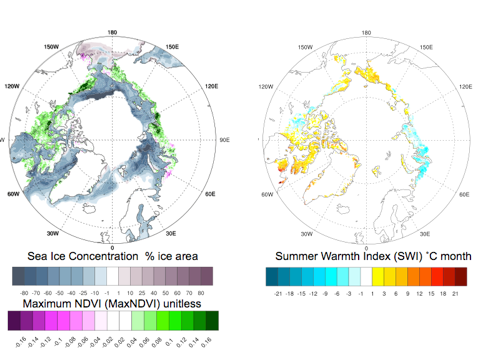A recent review of research on the response of plants, marine life and animals to declining sea ice in the Arctic found that sea ice decline and warming trends are changing the vegetation in nearby arctic coastal areas.
The review team analyzed 10 years worth of data and research on the subject. The findings show that sea ice loss is changing marine and terrestrial food chains. Sea-ice disappearance means a loss of sea-ice algae, the underpinning of the marine food web. Larger plankton is thriving, replacing smaller, but more nutrient dense plankton. What that means exactly is not yet understood.
Above water, loss of sea ice has destroyed old pathways of animal migration across sea ice while opening new pathways for marine animals in others. Some animals and plants will become more isolated. In the case of the farthest north and coldest parts of the Arctic, entire biomes may be lost without the cooling effects of disappearing summer sea ice.

Magnitude trends for (left) spring sea-ice concentration (%) (as represented by trends from the climatological 50% sea-ice concentration level) and (left) annual MaxNDVI (unitless). The right panel shows land-surface summer warmth index (SWI) (˚C month). Trends were calculated using a least squares fit (regression) at each pixel. The SWI is the annual sum of the monthly mean temperatures > 0°C, derived from AVHRR thermal channels 3 (3.5–3.9 μm), 4 (10.3–11.3 μm) and 5 (11.5–12.5 μm). The total trend magnitude (regression times 30 years) over the 1982–2011 period is presented. Figure courtesy of U. Bhatt, Geophysical Institute, UAF.
Skip Walker, a professor at University of Alaska Fairbanks's Institute of Arctic Biology, says warming soils provide an opportunity for new vegetation to grow where less vegetation occurred previously. This contributes to a general greening of the Arctic that is visible from space. They examined a 1982-2010 time series of remote sensing data to examine trends in sea ice, land-surface temperatures and changes in the vegetation abundance.
"Our thought was to see if sea ice decline contributed to greening of the tundra along the coastal areas," said
Uma Bhatt, an associate professor with University of Alaska Fairbanks's Geophysical Institute
. "It's a relatively new idea."
A surprise and puzzling finding shows that despite a general warming and greening of Arctic lands in North America, some areas in northern Russia and along the Bering Sea coast of Alaska are showing recent cooling trends and declines in vegetation productivity.
"We don't know why," Bhatt said.
This all illustrates the complexity of the arctic system and why scientists from different disciplines should work together to understand it, Bhatt said. The review article is one of the first steps in this direction.
"It's not a simple story here," Bhatt said. "I'm an atmospheric scientist and Skip (Walker) is a plant biologist. We have had many conversations to understand each other so we might better understand what's happening in the Arctic."
Citation: Eric Post, Uma S. Bhatt, Cecilia M. Bitz, Jedediah F. Brodie, Tara L. Fulton, Mark Hebblewhite, Jeffrey Kerby, Susan J. Kutz, Ian Stirling, and Donald A. Walker, 'Ecological Consequences of Sea-Ice Decline', Science 2 August 2013: 341 (6145), 519-524. DOI:10.1126/science.1235225






Comments